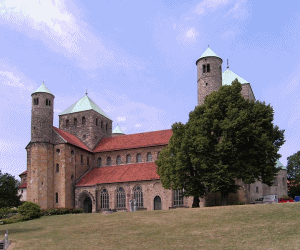St. Michael's church

St. Michael's was built at the beginning of the 11th-century under the direction of bishop Bernward who wanted to be buried in that church, bishop Godehard finished the church. The pre-Romanesque ('Ottonic') construction concept connects the idea of 'God's city' with a geometrical conception.
St. Michael's church counts as one of the earliest churches with a continuous connected system. In the 12th-century all but two columns were renewed and in the 13th-century finally the west choir extended as well as the painted long-house ceiling (genealogical tree of Jesus Christ) done. Apart from this ceiling painting as important interior the northern part of the late-Romanesque choir was preserved.
It is interesting that St. Michael's despite its re-consecration from a Catholic to a Protestant church the crypt is still Catholic consecrated. After several changes in the course of the centuries St. Micheal's was rebuilt in its original form after the war destruction and the glass windows by Charles Crodel finished.
It is one of the city's most well-known photo motifs and is seen as an urban landmark. The church is on the UNESCO World Heritage lists since 1985 and its brown sign-posts are used by the city as advertisement along the motorway A7 as they are more pregnant as the Hildesheim cathedral.
The motif of St. Micheal's is to be coined on the reverse of the German 2-Euro-coins in the year 2014. It will be then be part of the commemorative coin collection series for the state of Lower Saxony (2006–2021).

